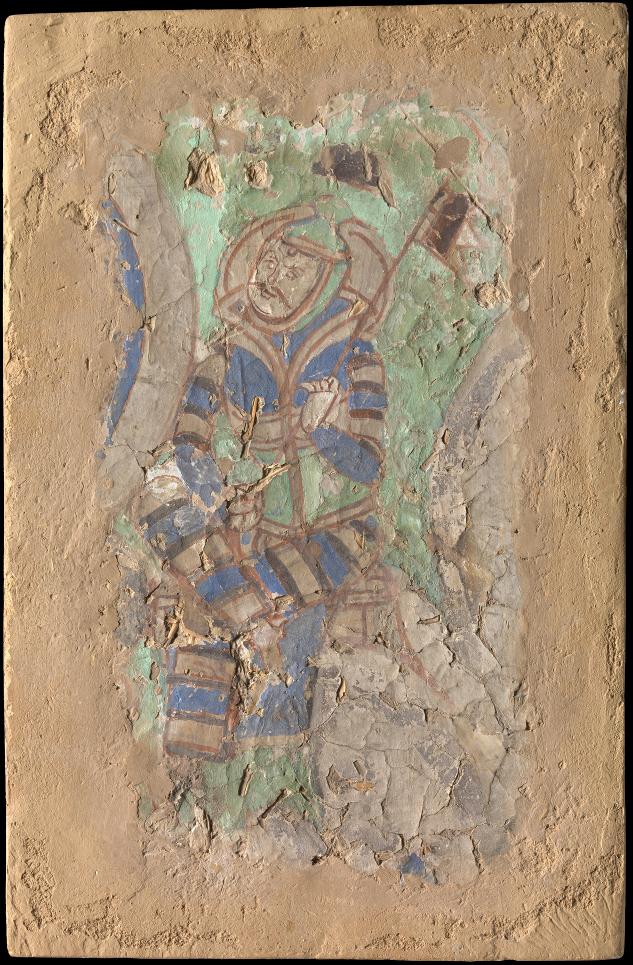
Create an Amazon Business Account
Central Asian Warrior
from Qieszil, Tarim Basin
5th–early 6th century

A larger image of this central asian warrior from Qieszil, Tarim Basin


Warrior
Date: 5th–early 6th century
Culture: Central Asia
Medium: Water-based pigment on mud plaster
Dimensions: 9 1/4 x 5 3/8 in. (23.5 x 13.7 cm)
Metropolitan Museum of Art, New York, Accession Number: 51.94.1
Armored figures are sometimes shown as devotees in the later cave temples at Kizil, at related sites such as Tumshuq, and in the secular wall paintings of Sogdia. They represent the ruling military elite who controlled the oasis kingdoms, such as those centered in Kucha on the northern part of the Silk Road and in Khotan on the southern branch.
Inscription: On back (pencil):
IV Reise Qieszil. gr. Anl.
Blaue Höhle
g. No. 2
[IV Travel Qizil {Kizil}
Blue cave]
fig. 8. Warrior. China (Xinjiang Uyghur Autonomous Region), Kizil, ca. 6th–7th century. Pigments on mud plaster, 9¼ × 5? in. (23.5 × 13.7 cm). Inscribed on reverse: IV Reise Qieszil. Gr. Anl. / Blaue Höhle / g. No. 2. The Metropolitan Museum of Art, Fletcher Fund, 1951 (51.94.1)
Warrior
The mustached Warrior (fig. 8) holds a small black banner trimmed with white triangles and attached to a pole. Horizontally striped armor covers the figure’s torso, arms, and legs, and the curved, trapezoidal helmet is topped with a semicircular black ornament. The Warrior sits cross-legged on a chair and turns diagonally to the left, toward a figure suggested by the edge of a large mandorla. A cone-shaped form similar to the ones in the border surrounding Attendant’s scene (see fig. 6) is present on the lower right.
The inscription Blaue Höhle (Blue Cave), penciled on the reverse, is the same as that found on the back of Attendant, indicating that Warrior, too, is from Cave 38.45 The painting’s predominantly green and blue colors match the color scheme of that cave, and it is clear from the figure’s position between the large mandorla and the conical form on the lower right that the fragment was taken from a lozenge-shaped segment on the ceiling. The rectangular patch of mud immediately to the left of the spot once occupied by Attendant is most likely the original location of this fragment, since Warrior’s bright green background and the beige conical form slot perfectly into this position. The white and blue concentric arcs on the Warrior’s proper right complete the mandorla of the Buddha figure still found in this lozenge-shape segment on the south side of the ceiling in Cave 38. Grünwedel’s record supports the argument that this was indeed the Warrior’s original location. It describes the figure in this particular rhomboid as “Buddha, meditating and seated, left, an armored knight.”46
Like Attendant, Warrior is associated with one of the tales of the preaching Buddha. While unidentified, the narrative was probably referenced repeatedly in the ceiling paintings of Kizil, as a similar armored figure with a flag is found in Cave 192 and elsewhere on the site.47
45. The complete inscription reads: IV Reise Qieszil. Gr. Anl. / Blaue Höhle / g. No. 2. Numbers preceded by g or G are found on other fragments also. They were possibly written later, when the works were inventoried; Ueno 1980a, p. 49.
46. Grünwedel 1912, p. 72 (description of ceiling segment 20).
47. Figures wearing the same type of armor as the MMA’s Warrior featured prominently in The Division of the Buddha’s Relics by Eight Kings, from Kizil Cave 224. (Formerly in the Berlin collection [IB 8438], that mural is now lost.)
Source: "The Kizil Paintings in the Metropolitan Museum" by Miki Morita in Metropolitan Museum Journal. Volume 50. (2015)